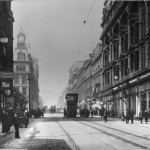 Sauchiehall Street is a name unique to Glasgow and yet known well beyond the city limits. It’s a long street by Glasgow standards and was renowned for its department stores, hotels, cinemas, restaurants and tearooms as well as art galleries and a range of smaller businesses. Much of the street is situated on a hillside that was probably once moorland, parts of which may have been wooded and others later cultivated. The sauchie haugh or willow meadow from which the street derives its name was probably a low-lying area located near what would later become Charing Cross. The development of Sauchiehall Street was part of the westward growth of the city, spurred by the desire of wealthy merchants to own property on the outskirts. Villas and terraces with distinguished names like Kensington and Windsor Place were constructed during the second decade of the 19th Century and the street became a quiet and narrow suburban thoroughfare known as Saughie-haugh Road. It was widened in 1846 and then in the 1850’s some of the older buildings were replaced with tenements and in the 1870’s with commercial properties. The 1896 Ordnance Survey map of Central Glasgow still shows some villas remaining on the north side of Sauchiehall Street in the section between Thistle Street and Scott Street.
Sauchiehall Street is a name unique to Glasgow and yet known well beyond the city limits. It’s a long street by Glasgow standards and was renowned for its department stores, hotels, cinemas, restaurants and tearooms as well as art galleries and a range of smaller businesses. Much of the street is situated on a hillside that was probably once moorland, parts of which may have been wooded and others later cultivated. The sauchie haugh or willow meadow from which the street derives its name was probably a low-lying area located near what would later become Charing Cross. The development of Sauchiehall Street was part of the westward growth of the city, spurred by the desire of wealthy merchants to own property on the outskirts. Villas and terraces with distinguished names like Kensington and Windsor Place were constructed during the second decade of the 19th Century and the street became a quiet and narrow suburban thoroughfare known as Saughie-haugh Road. It was widened in 1846 and then in the 1850’s some of the older buildings were replaced with tenements and in the 1870’s with commercial properties. The 1896 Ordnance Survey map of Central Glasgow still shows some villas remaining on the north side of Sauchiehall Street in the section between Thistle Street and Scott Street.
This shows the view looking west along Sauchiehall Street from the eastern end, at the intersection with Buchanan Street where the tram lines curve in from Parliamentary Road. Armstrong’s Hotel is on the left and on the right with its magnificent tower and Grecian temple front is St. John’s Methodist Church. The tower was taken down in 1957-58 to make way for St. Andrew’s House, a multi-storey office building, but the church itself remained in use until 1974.
On the left, beyond the intersection with West Nile Street, is the Baroque Empire Theatre which opened in 1897. It attracted some big name performers and particularly in the years after the Second World War when American stars including Bob Hope, Frank Sinatra, Judy Garland, Dorothy Lamour, Jack Benny and Danny Kaye played to packed houses.
Perhaps a good way to start our journey down the Sauchiehall Street of yesteryear is with breakfast at Armstrong’s Hotel at the far eastern end of the street. Their dining room affords a fine view westward along the first part of Sauchiehall Street as it rises steadily uphill into the distance. And we have a good view of the magnificent tower and temple frontage of St. John’s Methodist Church on the right.
The Empire Theatre, 35 Sauchiehall Street
Looking from the Empire Theatre diagonally across the intersection with Renfield Street was the Central Halls Building, a complex of offices, shops and a hall, designed by the architect James Thomson. The Royalty theatre opened there in 1879 and became famous for comedies, opera and plays. It served as the Glasgow base of the D’Oyly Carte Opera but when Howard & Wyndham’s lease ran out in 1913, the Central Halls Company who owned the property ran the theatre as the Lyric Picture Palace. During the First World War, the building was purchased by the YMCA and it became their Hostel for Soldiers and Sailors. After the war, the YMCA reopened the theatre as the Lyric Theatre. This picture shows the building when it was owned by the YMCA and it remained so until it was demolished in the late 1950’s. ( Publisher not known. )
This mid-1920’s view of Sauchiehall Street looking west was taken near the Renfield Street intersection. In the foreground is the entrance to the Lyric Theatre located in the YMCA building and there are businesses all along the frontage, including a branch of A. Harris, the tobacconist, and a service offering hair cutting, shaving, chiropody and manicure. Part of Renfield Street United Free Church is visible on the left, beyond the intersection, and a branch of R.S. McColl, the confectioner, has good exposure on the corner. ( Postcard published by Judges Ltd., Hastings )
This Valentine’s photo was taken at the same location in 1932 and the ornate street lights have now been replaced by more utilitarian ones with a longer reach, providing better illumination over the roadway. The policeman on point duty has stopped traffic so that the tramcar can turn right into Sauchiehall Street from Renfield Street. Three years earlier, the name of the church had been changed to Renfield Street Church of Scotland and it continued as such until it closed in 1964 when the congregation became part of what it now known as Renfield St. Stephen’s Church in Bath Street. ( Postcard published by Valentine’s of Dundee. )
A tramcar heading for the International Exhibition at Kelvingrove Park is just turning into Sauchiehall Street from Renfield Street in this 1901 scene. The city where the Industrial Revolution began was hosting its second great International Exhibition and the recent electrification of the tramway system served to further showcase Glasgow’s achievements. The cars were resplendent in their colourful livery of cadmium orange side panels, ivory trim and plum/brown for the dashes. Each route was colour-coded and car 664 in the foreground would have had chrome yellow panels above the windows, bearing route information, probably similar to that of the car in the background.
A young girl is focussed on the photographer in this view looking east along Sauchiehall Street towards Armstrong’s Hotel and Parliamentary Road in the distance. The Central Halls Building, housing the Royalty Theatre, is on the left of the picture and the magnificent tower of St. John’s Methodist Church can be seen further along the street. A crowded, former horse-drawn tramcar bound for Botanic Gardens is coming round the corner from Renfield Street while a smartly dressed man waits beside the kerb. Everyone wore a hat in those days and there is quite a collection on display.
This scene from an undivided back postcard is looking west along Sauchiehall Street from the Renfield Street intersection soon after the tramway had been electrified in 1901. The premises on the right are not yet occupied by Lumley’s and the adjacent building with the newsagent would be completely rebuilt and refitted as the Salon Cinema by June 1913. The Crown Halls next door were occupied by a firm of auctioneers and valuators. ( Publisher not known. )
In this view looking west across the intersection with Renfield Street, part of Renfield Street United Free Church is visible on the left and, on the opposite corner, Lauder’s Bar is on the ground floor of the building and Lumley’s the sports retailer now occupies the other three floors. The curious light-coloured building next door is the Salon Cinema which opened in June 1913. It was designed in the Moorish style by Thomas Baird and the facade was finished in square tiles set in a diagonal pattern. Patrons would enter through a large doorway framed by two pillars each side and topped with a grand arch containing three windows. Unfortunately, the business was not a success and it closed in May 1923, whereupon another major renovation began. The facade was replaced with a more contemporary one and three new floors were built within the space formerly occupied by the auditorium. When it was completed, Lumley’s moved into the premises. ( A “Pelham” Series Local View published by Boots the Chemist. )
This view of the same location taken after 1923 shows the completed Lumley House and Bruce’s Furniture Galleries now occupy the space vacated by Lumley’s on the corner. On the other side of Lumley’s are the Crown Halls. There is still a policeman on point duty as this was well before traffic lights were introduced. The tramcar approaching the intersection is bound for Clarkston. It had a long way to go. ( Postcard published by J. & M. Caledonia Series. )
In this scene, dating from around 1910, we have now crossed Renfield Street and are walking up the south side of Sauchiehall Street towards the intersection with Hope Street. We have passed the Crown Sale Halls on the opposite side of the street and are now looking across to the Globe Restaurant at number 110 and the Osborne Hotel, a temperance hotel listed in Baedeker’s 1906 handbook. The name Osborne had become popular during Queen Victoria’s reign as it was the name of her favorite home with Prince Albert on the Isle of Wight. The Glasgow hotel of this name would later become the Royal Hotel and, unlike the Osborne, it was not a temperance establishment. Until the Scottish licensing laws were changed in 1976 only hotels and restaurants could serve alcohol on Sundays and the Royal along with many others did a brisk trade. ( Postcard published by M. Wane & Co. Edinbro’. )
We have now moved up to the Hope Street intersection in this printed view which dates from the late 19th Century. Gas lamps still illuminate the streets and the trams are horse-drawn. The property housing Craske’s cloaks is the only two storey building fronting the south side of the street in the entire block. Cloaks are now out of favour but the term cloakroom still survives. Across the street from Craske’s is P. & P. Campbell of the Perth Dye Works, who operated a chain of cleaners and dyers. The driver of the horse-drawn cart making its way up the street is adhering to the path of the tramlines in order to reduce the bone shaking from riding on the cobblestones. ( Publisher not known. )
We have turned to look back, eastward across the intersection with Hope Street where traffic lights have now been installed in this late 1930’s scene. The Royal Hotel, formerly the Osborne, is on the left and beyond that are the Crown Sale Halls and Lumley House. In the distance is the YMCA and the magnificent tower and cupola of St. John’s Methodist Church. The bus pulling away from the kerb is unusual in that it has three axles and was an AEC Renown, the only one that was in service with Glasgow Corporation. In the distance, the street bares left into Parliamentary Road where the sun is shining on the tenement building. ( Postcard published not known. )
This view of Sauchiehall Street looking west across the intersection with Hope Street was taken soon after the tramway system had been electrified in 1901 and new, decorative electric street lights had replaced the gas lamps. Transport is powered by man, horse and electricity in this scene and it must have been hard work pulling a cart up Sauchiehall Street. A sign outside one of the shops on the left proclaims New Etchings by D. Y. Cameron, the celebrated artist and member of the Glasgow School, whose works were much sought after and who was later knighted by King George V. Across the street, P. & P. Campbell, the cleaners and dyers, are offering a special on carpets. The clock tower in the distance marks Copeland and Lye’s department store, usually referred to as Copeland’s, and beyond that is the dome of Pettigrew and Stephens.
In this unusual view of Sauchiehall Street, taken around 1920, the camera is looking down from a first storey rooftop on the south side of the street, near the intersection with Hope Street. The building with the light façade and bay windows across Sauchiehall Street is occupied by M. Bryce & Son, upholsterers, cabinet makers and carpet warehousemen. In the imposing building next door, considered by some to be the most handsome on the street, the Picture House is showing silent films. Years later, it would become the Gaumont. The dome in the distance is the cupola on the Treron building at the corner with Rose Street. ( Caledonia Series postcard published by J. M. & Co., Ltd. )
We are now back to street level and the date is around 1905. On the far right is the awning for M. Bryce, the cabinetmaker. We can now take a much closer look at the fine red sandstone building next door, designed by the brothers Hugh and David Barclay and completed in 1893 for Messrs. Cumming and Smith who had built up a successful carpeting and furniture business in Townhead. Surprisingly, after spending only 10 years on Sauchiehall Street, Cumming and Smith decided to move back to their old premises and now several small businesses line the front of the building. The Picture House would not open until 1910. Further up the street, at number 158, is the Rodmure School of Dress which would soon relocate to premises above Reid & Todd at the corner with Cambridge Street. On the south side of the street, the vertical development of the single storied block between Hope Street and Wellington Street has now begun with the completion of a multi-storey warehouse with space to let. The businesses in the adjoining premises are many and varied, including Stobo, the tobacconist, S. Langfier, the photographer and the Scottish Bible and Book Society, together with an importer, and an enterprise offering electrolysis. The ornate standards by the kerb are not bearing street lights but instead support the tram wires. When the system was electrified, there were no buildings on this side of the street tall enough to support the wiring. The tramcar in view, heading for Langside, is an early example of one with an enclosed upper deck. ( Photograph by T. R. Annan. )
We have now moved forward nearly thirty years and the south side of Sauchiehall Street between Hope Street and Wellington Street has changed completely. Craske’s Cloaks and the single storey buildings present at the turn of the century have now been swept away and replaced by more substantial properties. The left corner is now occupied by Watt Brothers, the ladies outfitters, which is still in business today having extended its premises and diversified its retail inventory. Next door at 123 Sauchiehall Street is one of James Craig’s tearooms whose excellent teas were complimented by their first class baking. The tearoom was rebuilt in lavish style and relaunched by James Craig as The Ruhl in 1927. Also occupying the same building is a branch of Birrell’s, the confectioner, and rival to R.S. McColl. At the time this photograph was taken, the very elegant, curved and embellished lampposts which had borne Glasgow’s first electric streetlights for over thirty years were being replaced with taller, more utilitarian versions which had a longer reach and would provide better illumination of the roadways. The great increase in motorized traffic had necessitated improvements in lighting. The sandwich board man is advertising a list of railway lost property items for sale, including furs.
Here is the scene in the 1950’s and traffic lights have now replaced the policeman on point duty. Traffic lights first appeared in Glasgow in 1937 and their introduction generated a lot of coverage in the newspapers. James Craig’s Ruhl, noted for its tea and cakes as well as Scottish paintings, would continue until 1957. The cinema known as the Picture House has now become the Gaumont. Glasgow people loved “going to the pictures” and the city was at one time home to over 130 cinemas, accommodating a total of 175,000 persons, over 10% of the total population. The cinema provided a great escape from hard work in the yards and factories and from loads of washing and ironing at home. ( Publisher not known. )
Continuing our walk along Sauchiehall Street we are now approximately halfway between Hope Street and Wellington Street and are about to pass the Picture House on the right with its cafe. This cinema opened in 1910 and would later become the Gaumont. A little further up on the left is the La Scala cinema which claimed to be more upmarket and offered “High Tea” while you were watching the film. The building with the clock tower which we are approaching on the left houses the Copeland & Lye department store.
We are now approaching the junction of Wellington Street with Sauchiehall Street and the rather fine French-styled building on the corner, known as Caledonian House, was occupied by Copeland & Lye Ltd., the department store. William Copeland and John Lye had founded the business in 1873 in Cowcaddens and five years later they moved to Sauchiehall Street. In 1901, the store was expanded to include premises at the Bath Street corner. Copeland’s specialized in drapery, clothing and dressmaking and was very popular with the ladies, even more so after they added a restaurant and tearoom. It was one of several large stores in the city to use a pneumatic cash transfer system which was fascinating to watch in operation. The sales person would write up your purchase and then enclose the details together with your payment in a cylindrical canister which was then loaded into a tube and conveyed at high speed on a cushion of air to the cashier’s office. After a brief delay, the canister would be returned to the sales counter in another tube, complete with the receipt and any change.
On the right of this photograph is the Sauchiehall Street branch of Woolworth’s, easily recognizable from the signature gold lettering on a rich red background. Frank Winfield Woolworth founded the company in the United States in 1878 as a “five and dime” store and it became an international success. Woolworth’s sold a range of household items, clothing, toys and confectionery, and was very popular with the people.
The Restaurant de Luxe
An advertisement in the Glasgow Herald of 22nd April, 1909 announced that Copeland & Lye’s new Restaurant de Luxe was now open to the public, and offered the following;
Dainty Luncheons. Light Refreshments. Afternoon Teas. First-Class Cuisine. Prompt and Refined Service. Moderate Charges. Ladies’ and Gentlemen’s Writing and Resting Rooms.
Music by the Caledonian House Orchestra from 1 till 5.
Stuart Cranston’s Waverley Temperance Hotel and Glasgow’s newly electrified tramway system are both featured in this 1901 Sauchiehall Street scene just before the intersection with Cambridge Street and West Campbell Street. A line of trams is coming up the hill and most are probably bound for the International Exhibition held at Kelvingrove Park from 2nd May to 4th November. ( Image scanned from a lantern slide in the collection. )
We have now reached the intersection with West Campbell Street off to the left and Cambridge Street to the right in this late 1920’s scene. Daly’s dress shop is in front of us on the left, and across the street, in the building which used to house the Balmoral Hotel, is the Ministry of Labour’s Employment Exchange. The fine domed structure further up on the right-hand side is part of the Treron et Cie building on the corner with Rose Street.
We are now looking back from whence we came and Cambridge Street is now on the left and West Campbell Street is on the right. The scene dates from around 1900 and the electric trams had only just been introduced. The two rather plain, four-story buildings on the left would soon be replaced with the fine Reid & Todd building shown below.
In this scene dating from around 1910, we are looking east along Sauchiehall Street past the intersection with Cambridge Street on the left and West Campbell Street on the right. The building with the large windows on the West Campbell Street corner is the location for Pettigrew & Stephens Manchester House, the famous department store, and on the other side of Sauchiehall Street is Reid & Todd’s, renowned for selling canes, umbrellas and fine leather goods, particularly for use in travelling. These two buildings, both completed at the turn of the century, display dramatic differences in architectural style. The Reid & Todd building, designed by James Thomson, appears much more conservative and is remarkable for its detailed stonework, especially around the roofline and dormer windows ( not visible in this photograph ). In dramatic contrast, the Pettigrew & Stephens building designed by John Honeyman & John Keppie and with a cupola by Charles Rennie Mackintosh represents a dramatic break with style and dedicates much more wall space to windows. The rounded corner at West Campbell Street emphases its modernity. It must have been so much brighter inside Pettigrew’s compared to other large stores. Above Reid & Todd’s is the Rodmure School of Dress which had recently relocated there. ( Postcard published by W. R. & S. Reliable Series. Printed in Saxony. )
It is now 1923 and the scene here is essentially the same with Reid & Todd and Pettigrew & Stephens facing each other across Sauchiehall Street. The sign on the corner of Reid & Todd’s reads J. Karter & Co. Wholesale Furrier and on the floor above are the offices of the Scottish Society for the Prevention of Vivisection. One can only wonder how the two got along. ( Postcard published by Valentine’s. )
It’s just after 3.25 on a sunny afternoon and the awnings are out at Reid & Todd’s and at Pettigrew’s. A few years have elapsed since the previous photo was taken. The anti-vivisectionists above J. Karter & Co. have moved out and the premises are now occupied by the staff of Berlitz Languages. Daly’s window displays in the foreground are attracting considerable interest. The store that was known as the “Harrod’s of the North” had a reputation for excellence in ladies clothing. Fashions have changed considerably since the Edwardian era and in this scene, raised hemlines and close fitting hats are much in evidence. The white colour-coded tramcar approaching the camera is bound for the University. ( National Series postcard published by Miller & Lang. )
This excellent photograph, dating from 1910-1912 and originally published by E. A. Schwerdtfeger, is taken from the north side of the street looking east and affords a good view of Manchester House, the Pettigrew & Stephens building on the corner with West Campbell Street. The fine cupola, designed by Charles Rennie Mackintosh, is in the centre of the building facing Sauchiehall Street, across from which we have a partial view of the building housing Reid & Todd which is contemporary with Manchester House but much more conservative in design. Nearer the camera on the south side of the street is Daly’s dress shop and the white building after Ramsay & Ramsay is the location for Kate Cranston’s Lunch & Tea Rooms. These were the famous Willow Tea Rooms, originally opened in October 1903 and recently restored. Charles Rennie Mackintosh and his wife Margaret designed virtually every aspect of the interior: the décor, furnishings, cutlery, menus and staff uniforms. In 1917, Kate Cranston sold her businesses and the tearooms remained open under a different name until they became a part of Daly’s in 1928. The sandwich board man outside is advertising Sylvia, the scientific palmist, at an address on Mains Street which would later become Blythswood Street. ( Postcard published originally by E. A. Schwerdtfeger and subsequently republished anonymously after the outbreak of the Great War. )
This photograph is taken slightly further west of the previous one and while not of the same clarity, it depicts a very important event. The date is 8th October, 1915, and a demonstration is taking place in support of the Glasgow Rent Strike. There are rows of quite well-dressed women, four deep, sometimes with a man on the outside, processing westward along the south side of Sauchiehall Street, perhaps heading towards Kelvingrove Park. Further back, a large crowd is following them, carrying placards and passing by Copeland & Lye and Pettigrew & Stephens stores. The Rent Strike was brought about by the attempts of landlords to raise rents at a time of economic crisis during of the war. Munitions factories and shipyards needed more workers and so the demand for rental housing increased. Landlords took advantage of this and when people could not pay the increased rents they were forced out onto the streets. There was a public outcry and a rent strike that began in Govan rapidly spread to Partick and other areas involved with the war effort. Because so many men were away fighting for their country, women played a prominent role in the strike. Demonstrations were organized and when landlords attempted to evict tenants, crowds would block the closes and drive off the Sheriff’s officers and landlords factors. The Government, led by Lloyd George, became so concerned about the threat to war production on Clydeside that it passed the Rent Restriction Act, fixing rents at pre-war levels for the duration of the war and forbidding landlords from raising them.
The large mobile hoarding on the far right is advertising the final week of Rob Roy at the Savoy Theatre, starring John Clyde and Durward Lely in the leading roles. A film version featuring the same two performers had been made in 1911. John Clyde was primarily an actor and Durward Lely had trained as an opera singer in Italy and was a noted tenor.
We have now crossed over to the south side of Sauchiehall Street and are looking across to Brinkley & Son, Miniature Printers, and the Balmoral Hotel, located on the corner with Cambridge Street. An early motorized delivery van is parked outside Muirhead & Turnbull, the piano and organ supplier immediately beside the hotel. Beyond the intersection is the building housing Reid & Todd and the Rodmure School of Dress. In the foreground, the larger stores have given way to small businesses including Miss Boyle and Mrs. Brown both of whom are selling corsets which were becoming more popular as girth increased with prosperity. ( Postcard published by Judges Ltd., Hastings. )
In this 1932 view, we have come further west and are now looking back. We have passed the intersection with Rose Street shown on the left and Blythswood Street, which used to be called Mains Street, on the right and are now standing outside the entrance to the McLellan Galleries in the Treron building. Built in 1856, the Galleries were named after their founder Archibald McLellan who was a coach builder, city councillor and patron of the arts. It was here that the Glasgow School of Art was housed from 1869 to 1899 until it moved to the new, purpose-built premises designed by Charles Rennie Mackintosh on Renfrew Street, just north of Sauchiehall Street. During this time of transition, the group of modern artists known as the Glasgow Boys, renowned for their pursuit of naturalism and realism, were particularly active. Sharing the building with the McLellan Galleries was the department store of Treron et Cie which was not French but wanted to give the impression of being so and was renowned for fashion and fine quality goods. ( Postcard published by Valentine’s. )
This 1924 photograph, taken just west of Dalhousie Street ( left ) and Douglas Street ( right ), shows the full size and scope of the Treron et Cie building which also housed the McLellan Galleries and the Royal Glasgow Institute of the Fine Arts. The latter, founded in 1861, thrives to this day and is in the forefront of promoting contemporary Scottish art. Posters in the windows of Treron’s advertise their July sale and the McLellan Galleries are hosting an Exhibition for the World’s Sunday School Convention. It was a busy time. Very ornate and unique lamp standards are fronting the Treron building and two fine cupolas are in view, one at the Rose Street corner of the Treron building and the other at the West Campbell Street corner of Pettigrew & Stephens. The architectural dome is probably the most graceful feature of classical architecture and here we see two of them in close proximity on Sauchiehall Street. The white tramcar approaching the camera is headed for Woodlands Road and the University at Gilmorehill. ( Publisher unknown but this postcard may be a successor to the pre-war E. A. Schwerdtfeger series. )
It is the early 1930’s and we are looking east along Sauchiehall Street from the corner with Elmbank Street. If the clock is right, the shops and offices have closed for the day and people are heading home. A crowd has gathered outside Lyon’s, the Society Stationer, to view the large selection of postcards and prints on display. In true entrepreneurial spirit, the shop is offering to print visiting cards for tourists while they wait. Obviously having a printing press on the premises gives them a distinct advantage over most stationers. The fine red sandstone building across the road, extending eastward from the Thistle Street ( now Garnet Street ) corner, is known as Ashfield House and was designed by T. L Watson and Henry Mitchell. It was completed in 1903 and incorporates both tenements and shops. ( Caledonia Series postcard published by J. M. & Co., Ltd. )
The full extent of Lyon’s retail premises on the corner with Elmbank Street can be appreciated in this picture, taken during the Edwardian period, when the business was at its height. Founded by William Lyon when he was only 23 years old, the company prospered and by 1885, there was the shop at 385 Sauchiehall Street, a printing works at number 474 Sauchiehall Street and a retail branch in the Argyll Arcade. This particular postcard is dated 20 October 1908 and was used to respond to a customer inquiry. A full account of the history of the company by family member Peter Andrew Lyon may be found at http://www.livinghistory.co.uk/homepages/Lyon/ ( Postcard published by Lyon Ltd., Glasgow. )
We are standing on the south side of Sauchiehall Street between Newton Street and Elmbank Street in this late 1940’s view. The large building with the white façade on the other side of the street is the Beresford Hotel which opened in 1938 in time to provide accommodation for visitors attending the Empire Exhibition. Often referred to as Glasgow’s first skyscraper, the building was designed by William Beresford Inglis who was also the owner and managing director. It is one of the city’s most notable examples of Streamline Moderne architecture, a design style which appeared during the latter part of the Art Deco period. The hotel was a favorite with American servicemen during the Second World War and later became Baird Hall of Residence for University of Strathclyde students. It has now been converted into private apartments. ( Postcard published by Miller & Lang in their National Series. )
We are now very close to Charing Cross in this view taken early in the 20th Century, after the tramway had been electrified in 1901 and before the last tree on this part of Sauchiehall Street was removed in 1906. On the left are the Albany Chambers, designed by Sir J. J. Burnett and completed in 1896. The entrance is flanked by Gavin Crawford & Sons and Hugh Dunlop & Sons with the former having their end of season sale. The sober storefronts of the period do not detract from the fine architecture. Long dark dresses and wide-brimmed hats are much in evidence in this Edwardian scene. ( Rotary Photographic Series postcard )
In this scene, taken from the pavement outside the Grand Hotel and looking east up Sauchiehall Street, the tramcars are still the dominant mode of transport but motor cars are becoming more evident and there is also Leyland Titan Corporation bus, the first of which entered service on Glasgow streets in February 1928. The entrance to the Grand Hotel is just visible on the left, flanked by pillars, and Harris the tobacconist, R. S. McColl and the Royal Bank occupy premises along the front. Hemlines are going up, as illustrated by the two ladies chatting beside one of the hotel lamp standards.
This view, looking East along Sauchiehall Street, was taken from an upper room in the Grand Hotel. On the left are the Charing Cross Mansions, superbly designed by J. J. Burnet for Burnet, Son & Campbell and built in red sandstone in 1889-91. Newton Street opens on the right and William Skinner’s tea rooms are on the ground floor at the corner facing the camera. William Skinner & Son was one of the oldest established tea room enterprises in Glasgow, having been founded in 1835. The business started out further up Sauchiehall Street and in due course established a reputation for teas and luncheon. The premises were furnished in the French style and cultivated an atmosphere of conservative elegance. ( There is some discussion of William Skinner & Son’s enterprise in the comments section. ) On close examination, the Standard tram cars in view are fully enclosed and still have the color-coded upper panels so this view probably dates from the mid to late 1930’s. ( Postcard published by Photochrom Co. Ltd., Royal Tunbridge Wells.)
Legends © Christopher J. Jones
Except where otherwise stated, all photographs are from the author’s collection.
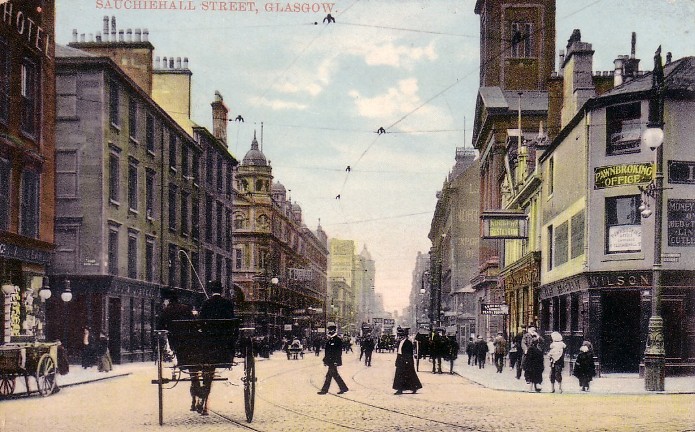
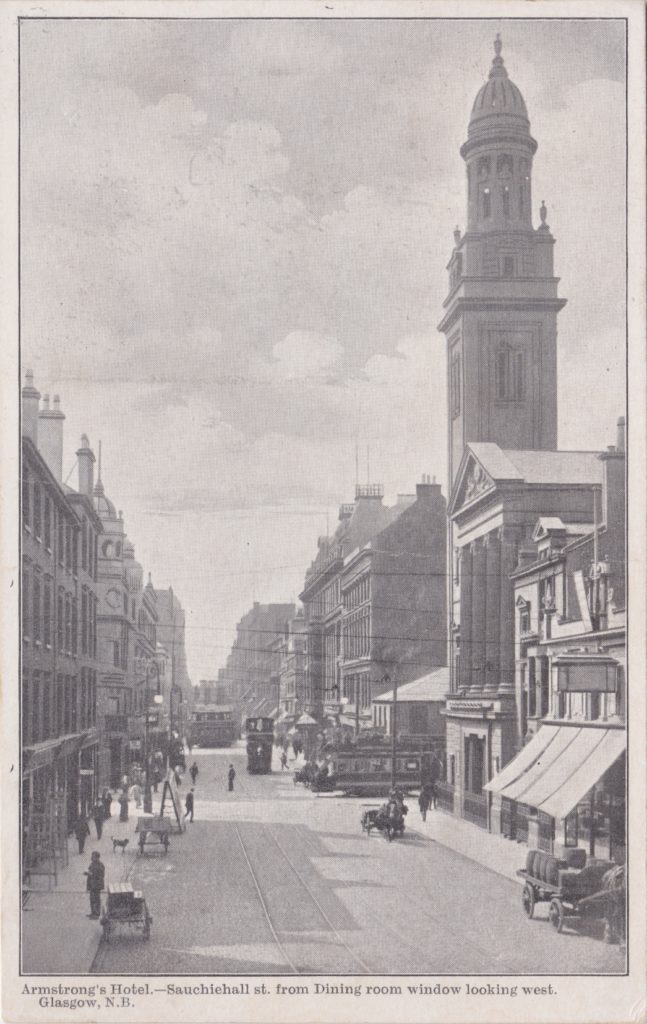
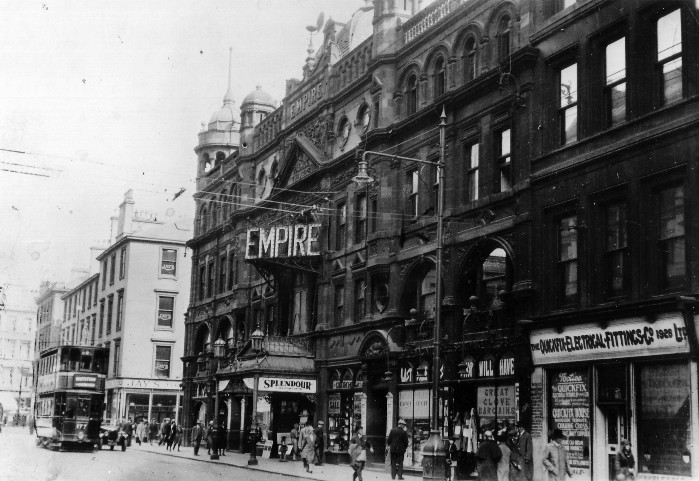
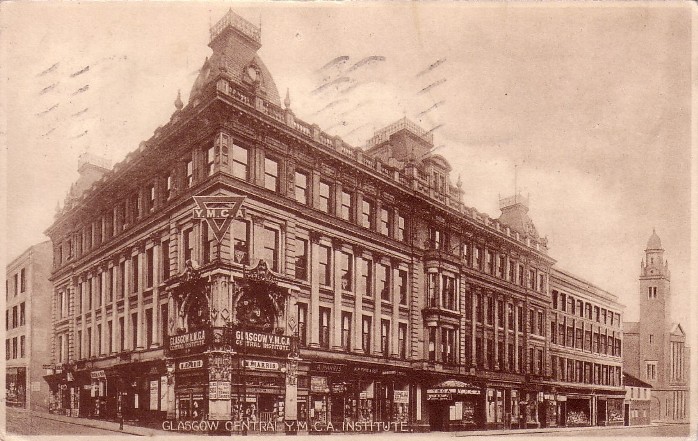
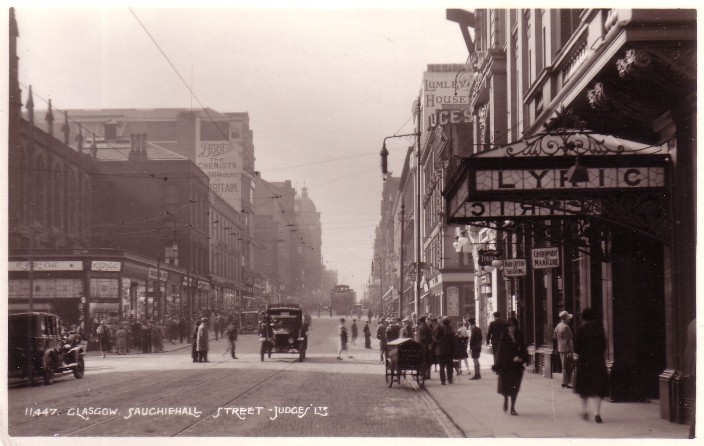
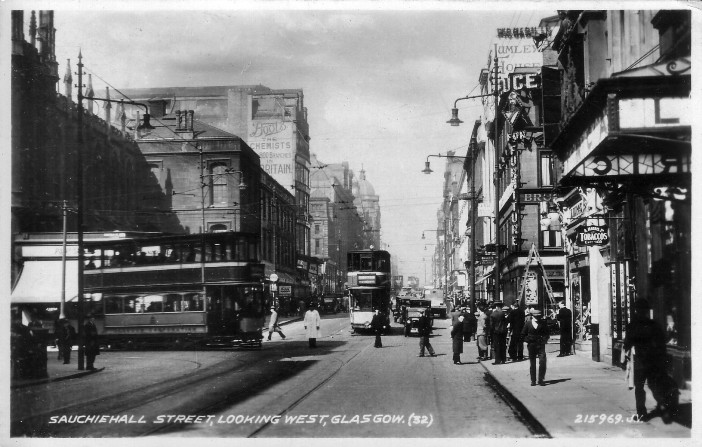
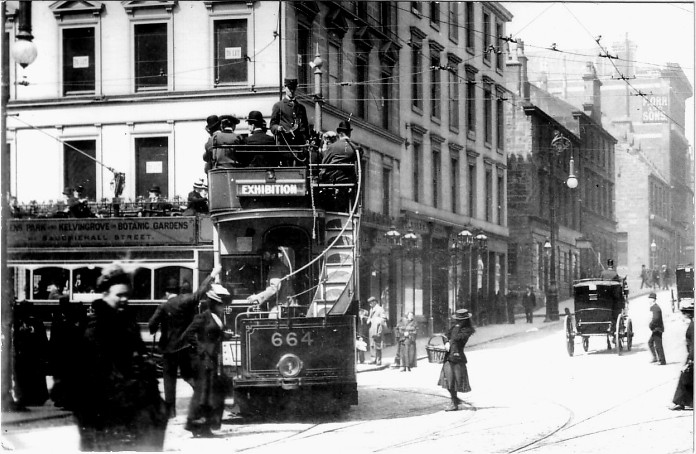
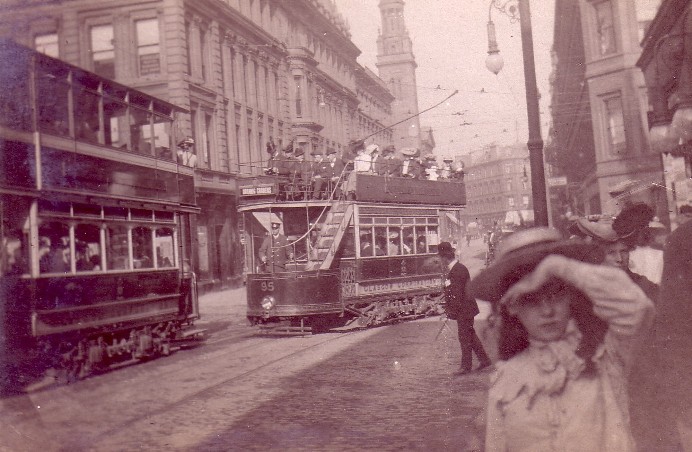
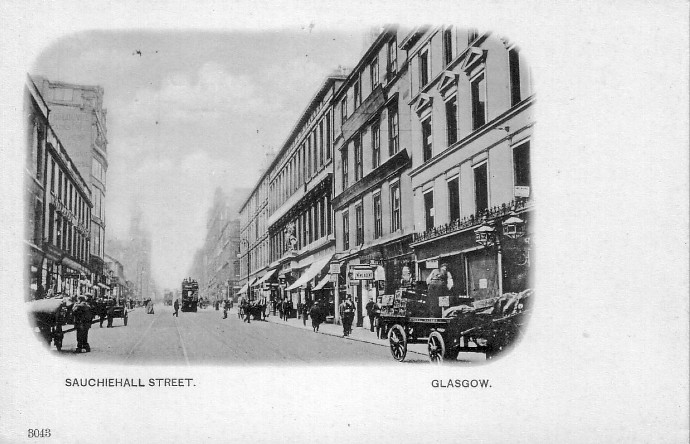
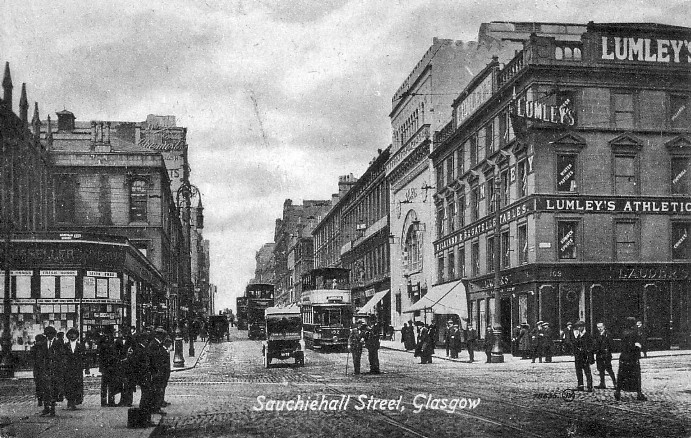
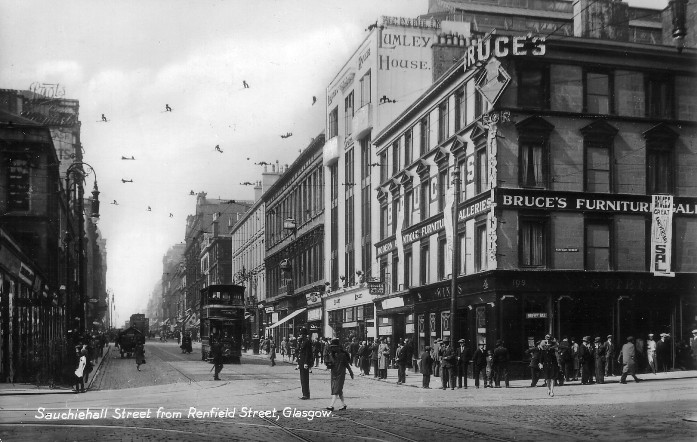
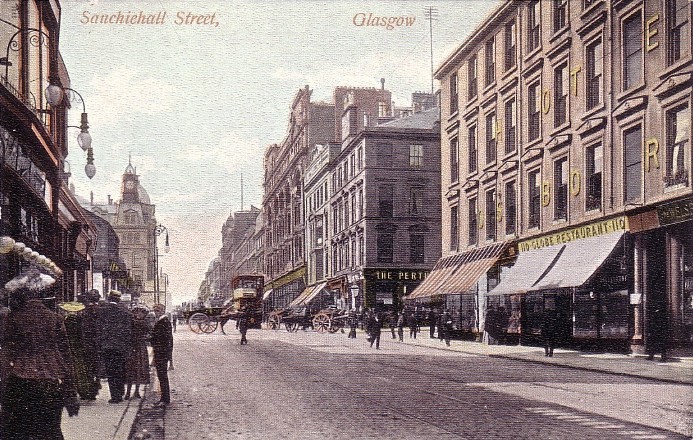
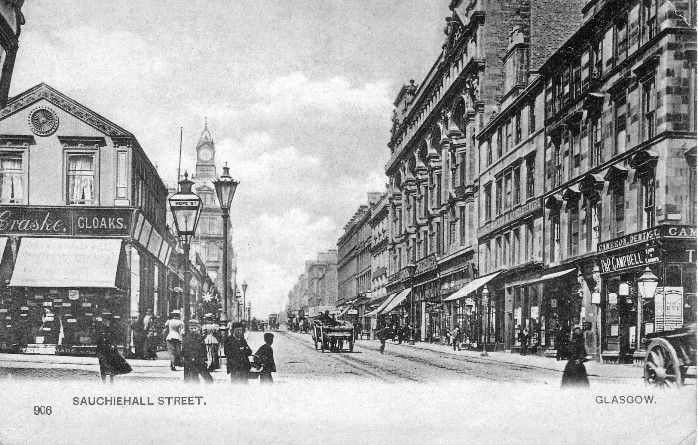
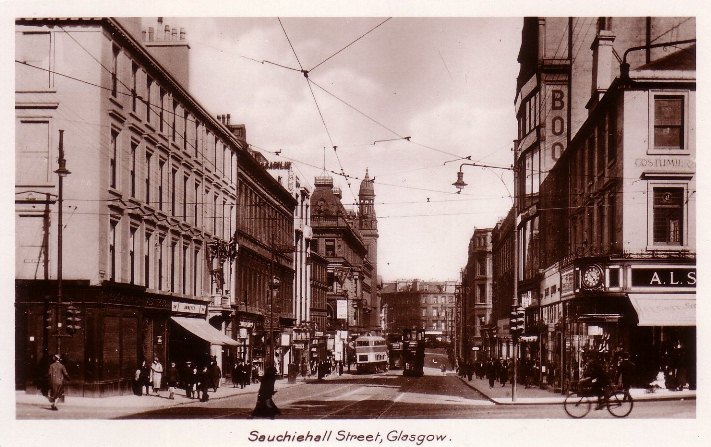
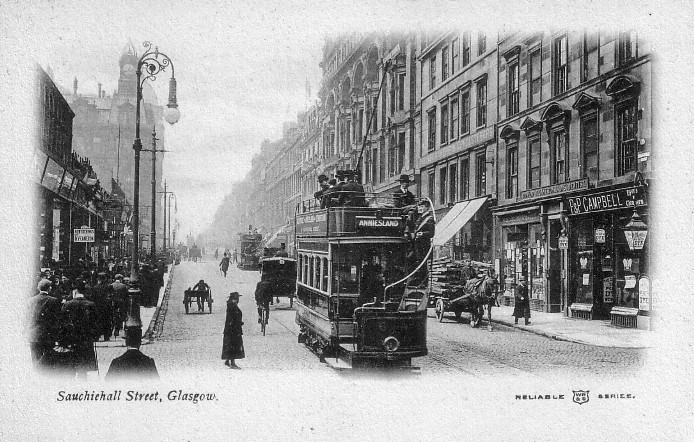
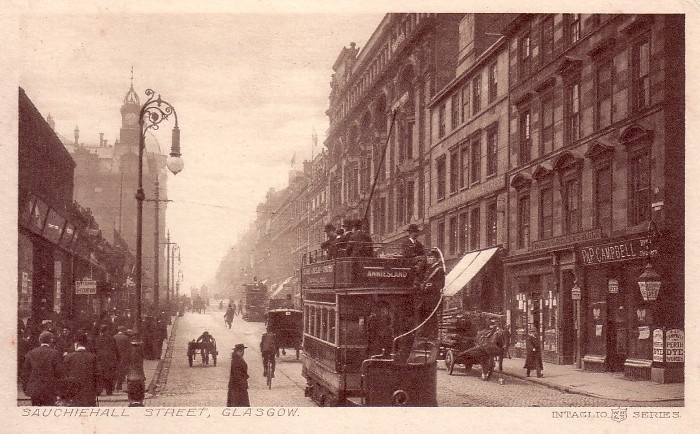
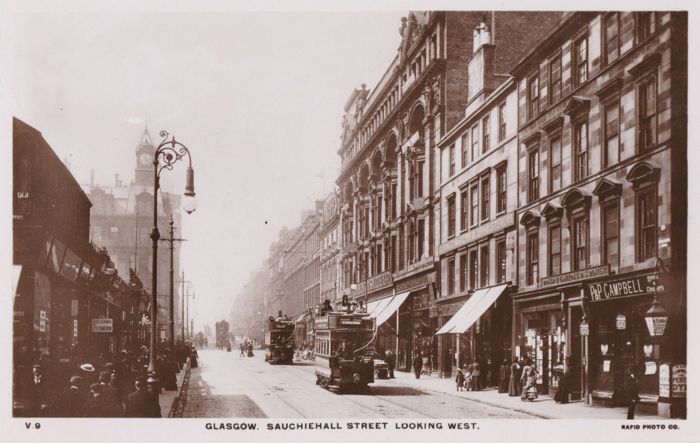
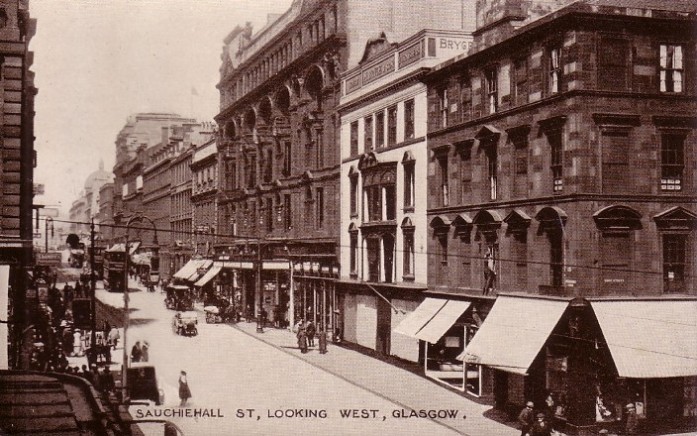
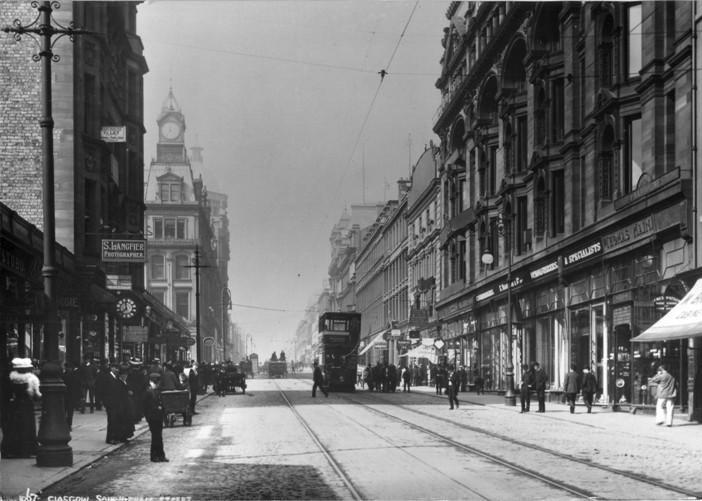
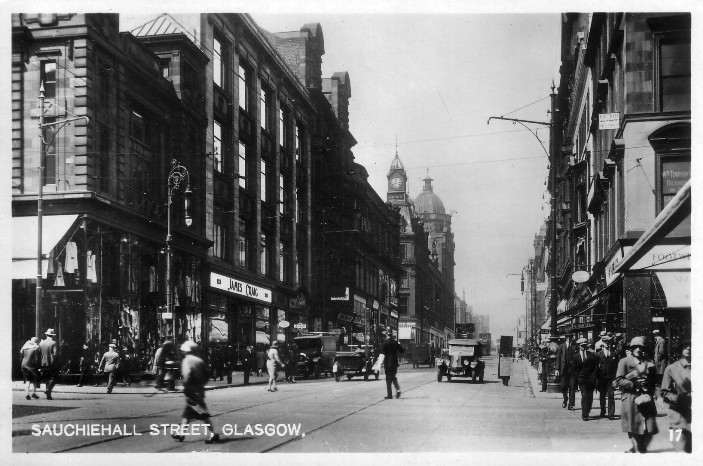
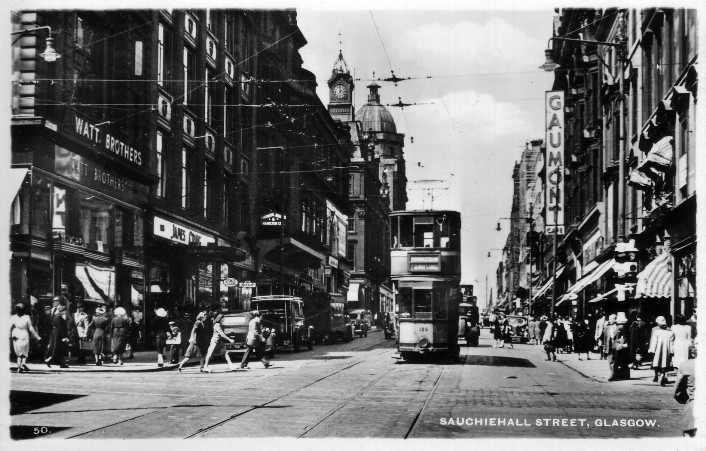
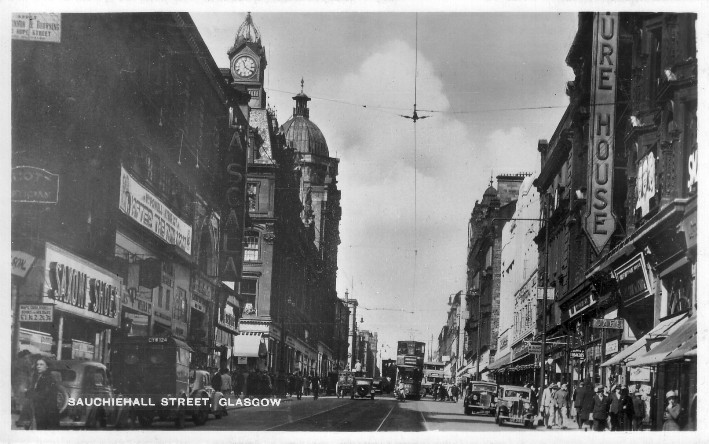
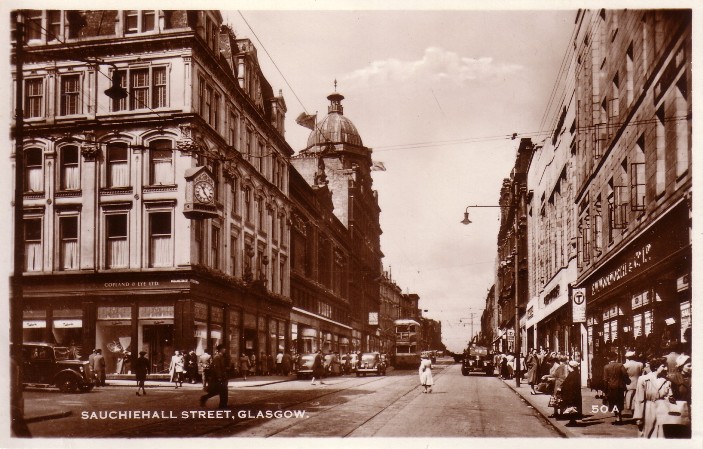
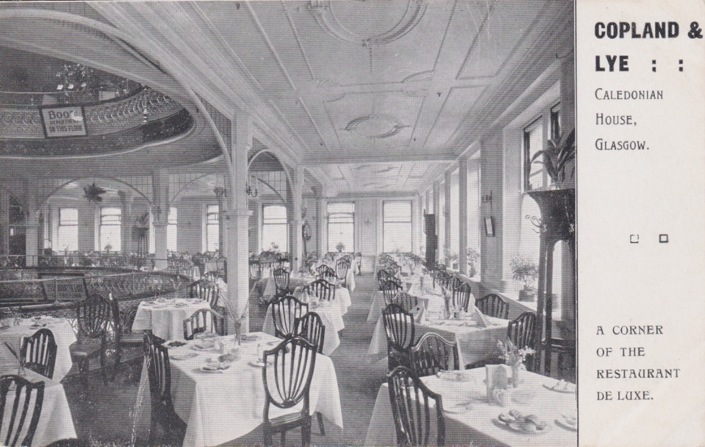
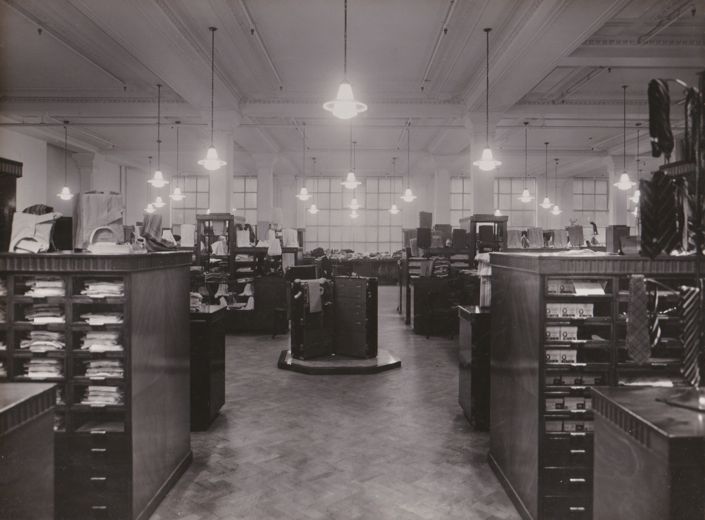
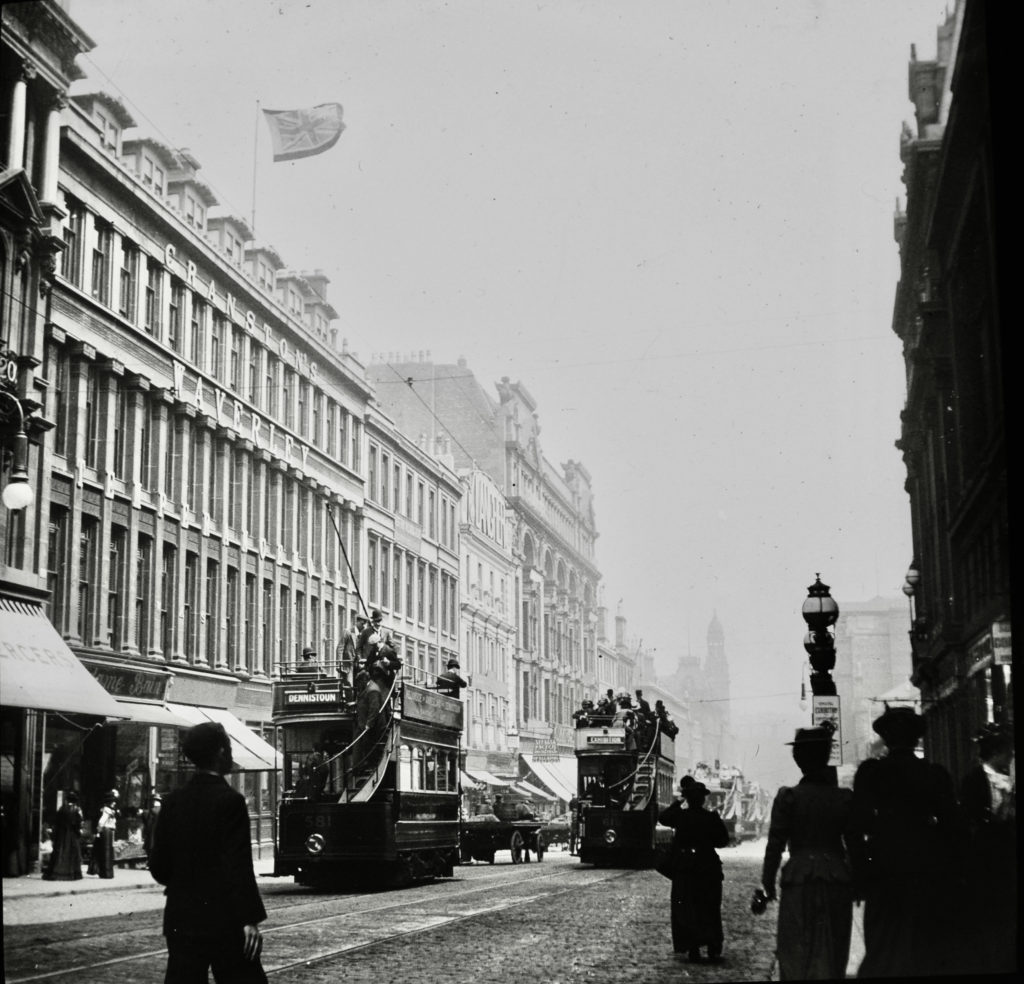
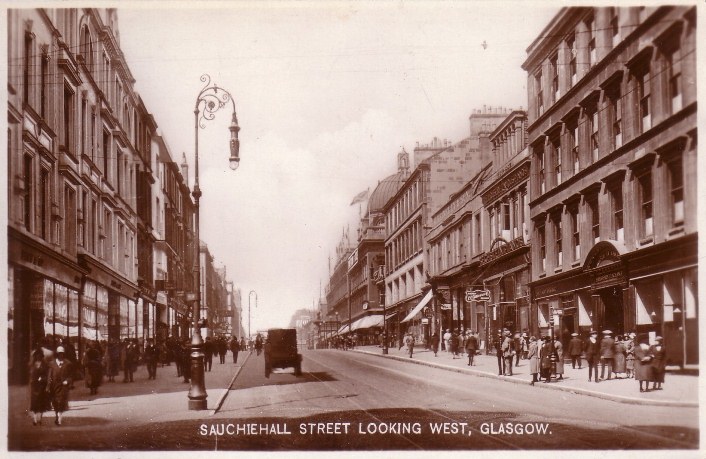
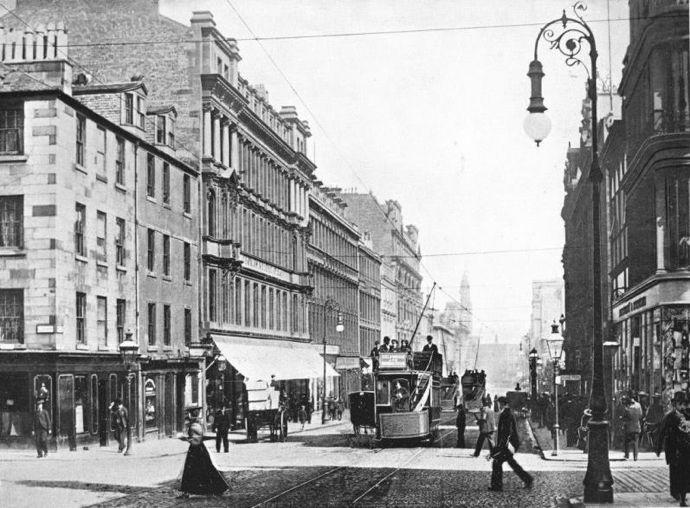
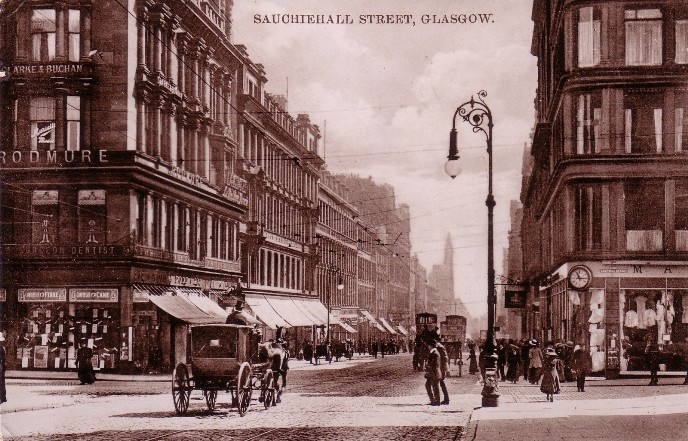
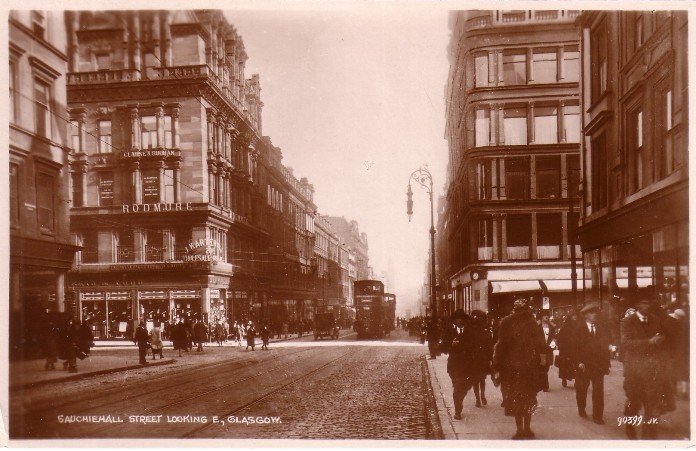
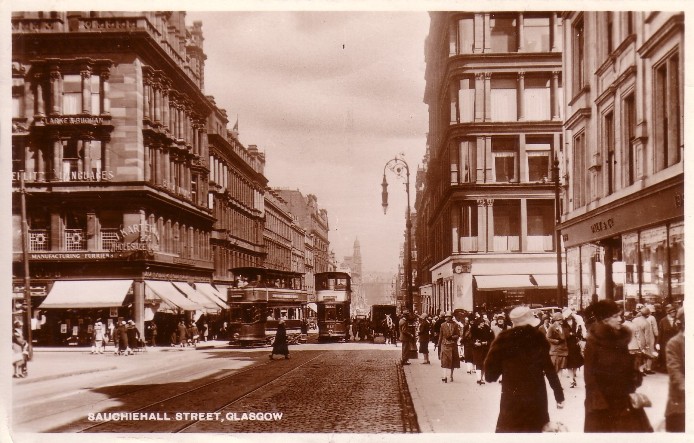
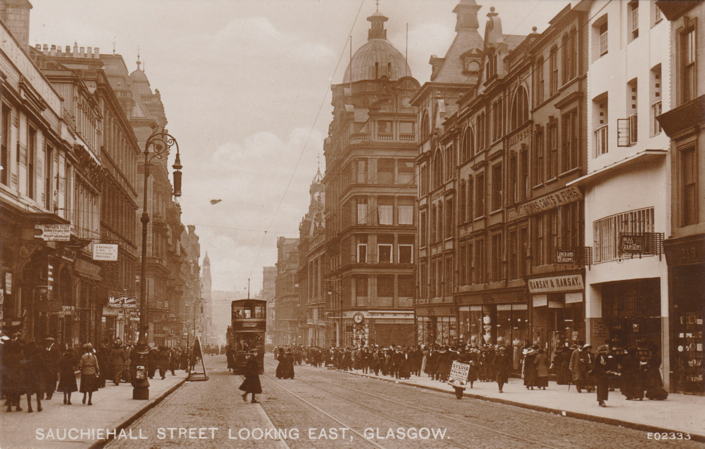
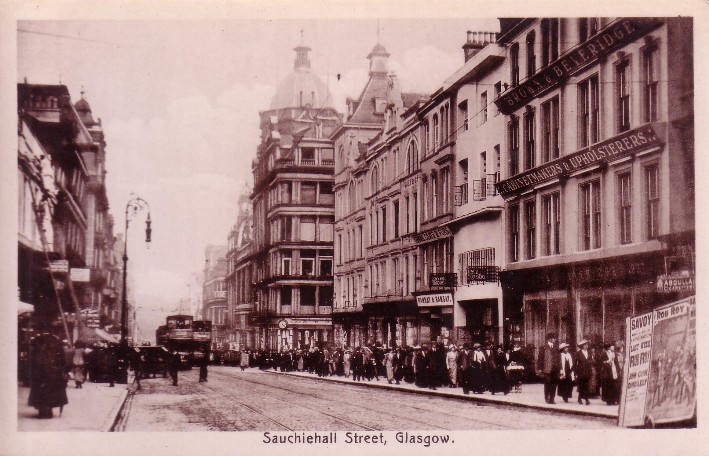
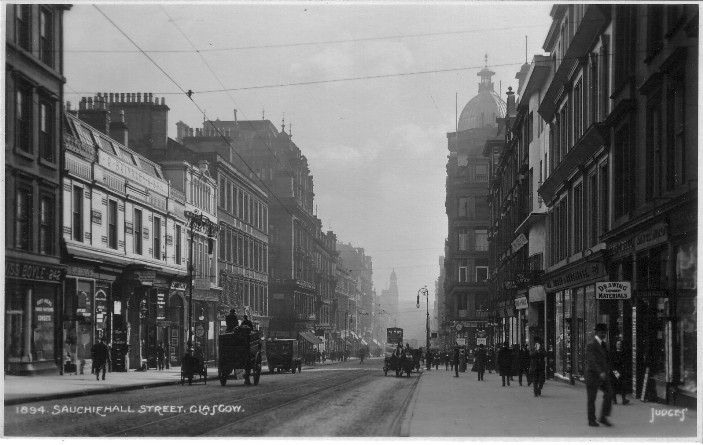
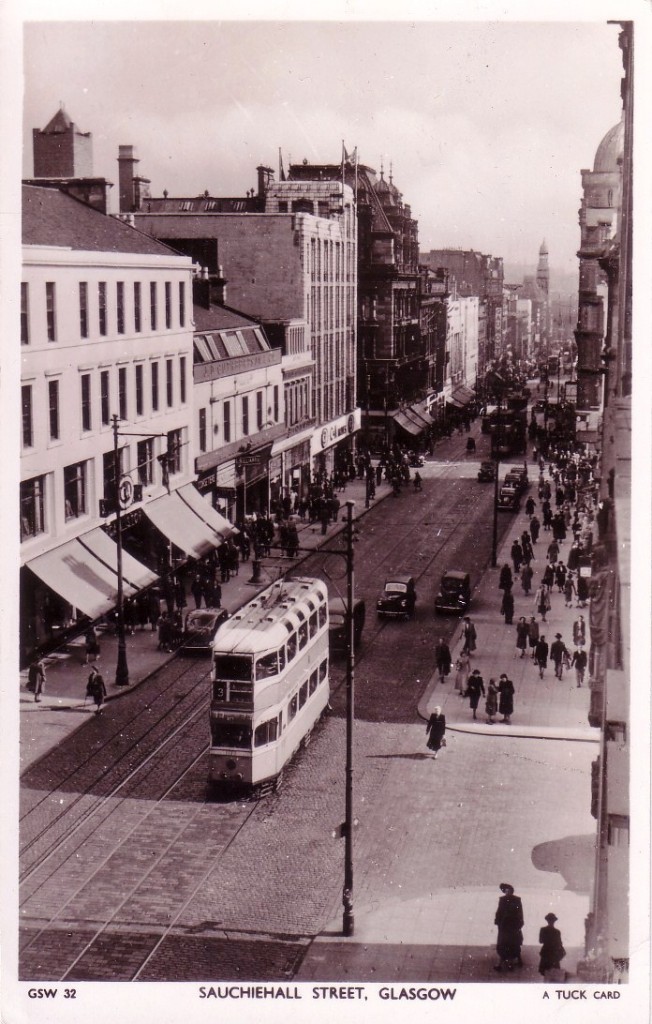
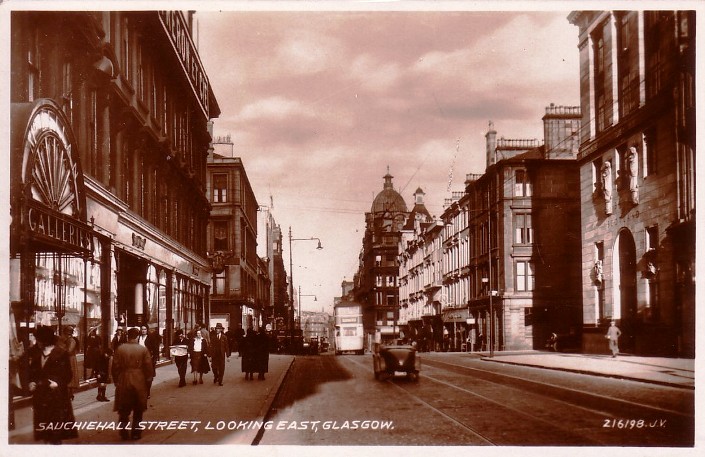
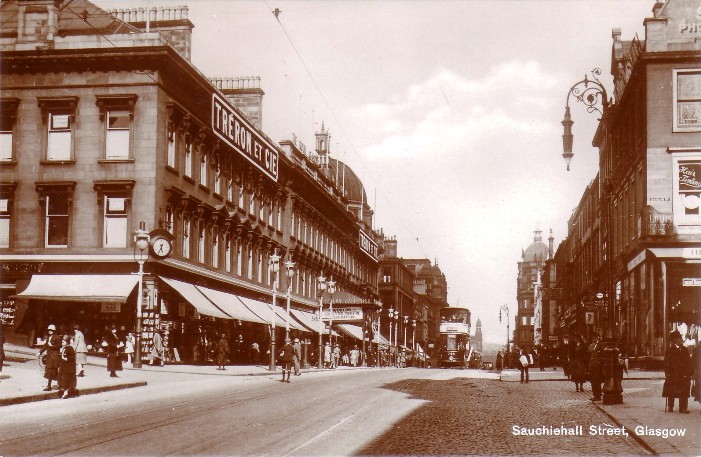
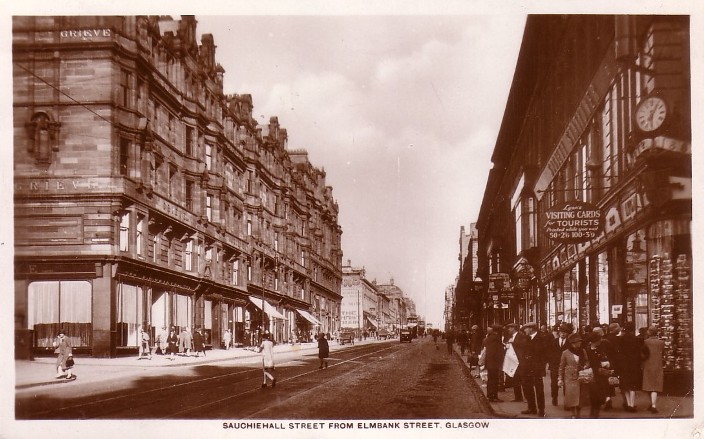
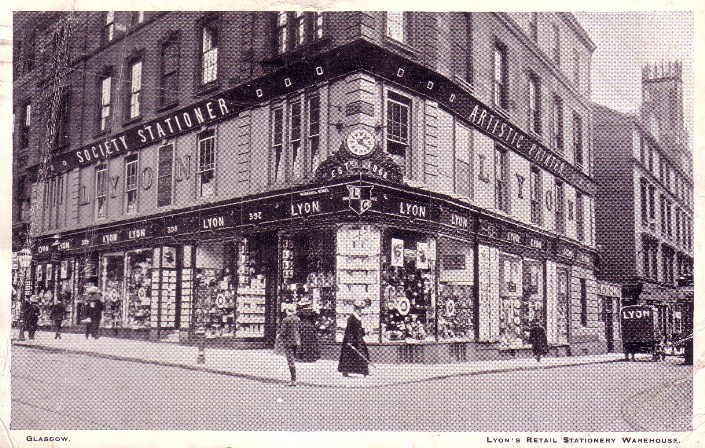
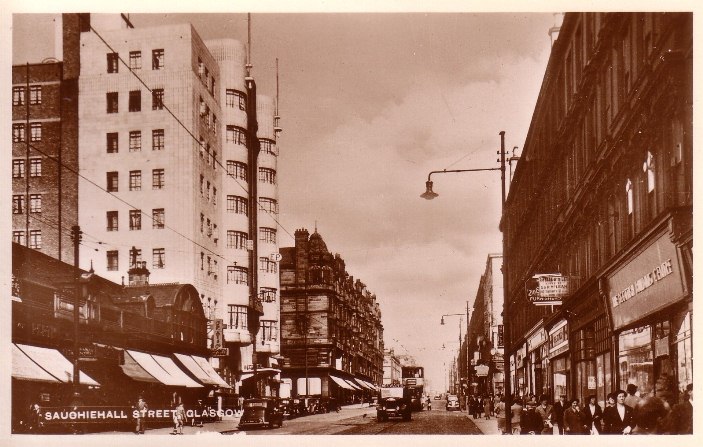
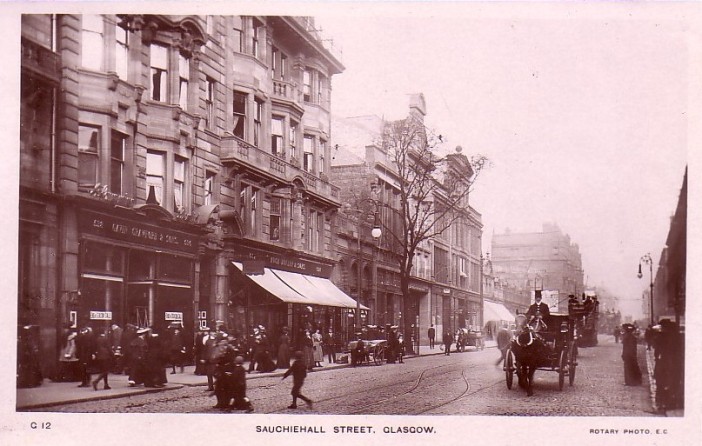
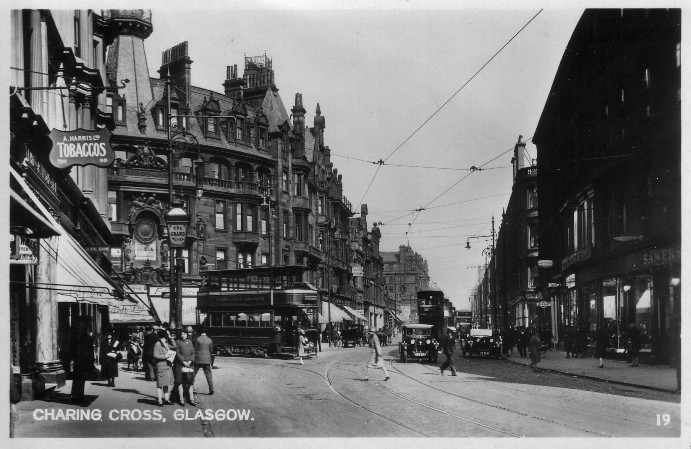
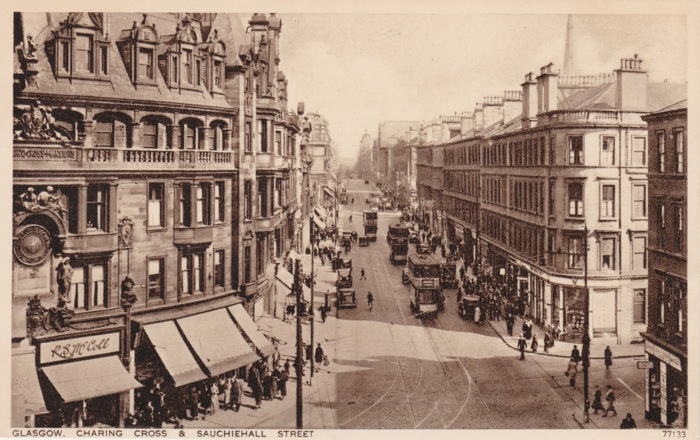

{ 3 trackbacks }
{ 56 comments… read them below or add one }
← Previous Comments
Hello Chris,
I would please like to find out the copyright of the pictures. I would like to use a couple as art work in a cafe, so would like to know if that is possible. Do I have to pay for the rights to display the images or if there is anything I need to do to avoid any legal action?
Regards,
Natalie
Hello Natalie,
Please forgive the delay. I’m involved in another international move. You are welcome to use any of the photos and should have no copyright worries, especially if you select scenes predating 1930, which so many of them do.
Best wishes,
Chris
Can anyone tell me if there was any record of a Decorator’s shop in Sauchiehall Street (Kiernan). I have a picture of my Great Grandparents outside a shop 1920-1940. I think I was told that it was in Sauchiehall Street. I would be most grateful for any information.
Thank you.
Pete Lewis
Hi Chris,
What an interesting collection of old Glasgow photos. If someone can help me, I am trying to find out where possibly there was a Sauchiehall Public School, or grammar school? I have two different family (Suttie/Blyth) school photos and was wondering where this school might have been in the early 1900’s? Any help would be appreciated by a colonial (Canadian) such as me.
Cheers,
Ken
Hi Chris,
I am eager to get hold of high resolution digital copies of some of the above photographs of Sauchiehall Street for use in an exhibition. Can you please contact me to let me know if this is possible.
Many thanks,
Philippa
Hi Chris,
In the 1901 census, my great-grandfather is recorded as living at 127 Sandyford Street, which I think I read somewhere was later integrated into Sauchiehall Street. Can you possibly confirm this, and which part of Sauchiehall Street it was? I’m hoping it was very near a Furriers.
Thank you.
Trevor
Hi Pete,
In the Post Office, Glasgow Directory for 1930-1931, https://archive.org/details/postofficean193031glas I found a listing for a James Kiernan, painter at 23 Hastie Street C3, home address: 2 Cloberhill Road W3. Could this be your relative? Hastie Street is mapped as being off Old Dumbarton Road at Lumsden Street, nor far from the Glasgow Art Gallery and Museum. You can see the location by entering a search for Hastie Street, Glasgow.
Best wishes,
Chris
Hi Trevor,
Thank you for your inquiry. You may be thinking of Sandyford Place which is an inset on the south side of Sauchiehall Street and faces Clifton Place and Somerset Place on the north side. Sandyford Street is actually in Kelvinhaugh and used to continue through to Kelvinhaugh Wharf on the River Clyde. You should be able to see a map of the location by entering Sandyford Street, Glasgow, on Google.
Best wishes,
Chris
Hi Philippa,
Thank you for your inquiry and for your interest. The archive is all packed up at the moment as part of a big move but you are welcome to copy any of the photos in the Sauchiehall Street chapter if that helps. You could also search on eBay and obtain some early photographic postcards that are out of copyright and scan them at high resolution for your exhibition. If there are specific photographs from my chapter that you like, I could try to locate them and scan them for you.
Best wishes,
Chris
Hi Ken,
Thank you for your inquiry. I’m not aware of any former Sauchiehall Public School, but both branches of Glasgow High School, a grammar school, used to be very close to Sauchiehall Street. The High School for Boys was at 120 Elmbank Street which joins Sauchiehall Street from the south, close to Charing Cross, and the High School for Girls was in Garnethill which is just north of Sauchiehall Street. Glasgow High School was a selective school operated by the City of Glasgow until the school became independent in 1977.
https://en.wikipedia.org/wiki/High_School_of_Glasgow
Best wishes,
Chris
Hello Chris
I am full of admiration for this stunning collection and your presentation of it. I am shortly republishing (via NMS Publishing) a revised edition of my short biography of Miss Cranston, and would love to be able to use the Schwerdtfeger view of Sauchiehall St Looking East which includes the Willow Tea Rooms. We would need permission and ideally a high res scan: is there any chance you could supply that? I have looked on ebay on the offchance but can’t see anything there.
I would be extremely grateful for your help, though I see from earlier posts that it may not be a convenient time for you. Thanks again for sharing this wonderful resource and all the fascinating detail you have supplied.
Best wishes
Perilla
Hello Perilla,
Thank you for your message and kind comment. I am honoured by your interest and appreciate your writings on aspects of Glasgow History. I have two of your books, “Tea and Taste: The Glasgow Tea Rooms: 1875-1975” to which I referred in an earlier chapter, and “Miss Cranston: Patron of Charles Rennie Mackintosh”. I see you have also co-authored a book on Glasgow’s Great Exhibitions which must be fascinating.
I have located the postcard to which you refer and will email some high resolution scans. I think the quality and subject matter of the E. A. Schwerdtfeger postcards make them some of the finest ever produced on the city.
Best wishes,
Chris
Hi Chris,
Many thanks for the detailed Sauchiehall Street picture history. Well timed, as I am writing the history of Reid & Todd, my maternal family business. When Henry Todd selected that corner site opposite Pettigrew & Stephen in 1900, he could not have realised that it would become one of the most prestigious fashionable shopping centres of the 20th century. Look at the crowds of smart ladies all window shopping in Daly’s, C & A Modes, Pettigrew’s and Reid & Todd, and don’t forget “see you at the Willow for tea.” It is a happy significance that the photographers have managed to capture “white” tram cars in their pictures and a Coronation car with No. 3 University via Pollokshields on the indicator board. I was born and brought up at 28 Aytoun Road in Pollokshields and Henry Todd occupied No.1 Aytoun Road where my mother was born. The white trams play a large part in our family history.
I note from previous replies that I may use your pictures in my book with attribution, many many thanks for lots of nostalgia, from and 88-year old Glaswegian down under in Balingup, South Western Australia.
Douglas Gordon.
Dear Chris,
It has been a pleasure perusing your exceptional evocative collection of photographs. I am looking to create a series of educational videos featuring past and present composite images of demolished Glaswegian architecture. I was wondering whether it would be possible to use some of the images featured in this chapter for the aforementioned project? I would of course ensure that I listed your blog as the source of the images in order to supply the proper accreditation.
Yours gratefully,
Daniel Hill
Hi Douglas,
Thank you for your comment and fascinating account of your family background. You are most welcome to use whatever photos you wish for your work. As you probably know, the “White” cars were Standard trams with a broad white panel separating the lower and upper decks. These trams were superseded on the Mosspark to University service by Mark I Coronation cars.
Best wishes,
Chris
Dear Daniel,
Thank you very much for your kind comment and you are welcome to use images from this chapter for your educational videos. Let me know if you need high resolution scans of the images that you would like to use.
Best wishes with your venture,
Chris
Hi Chris,
Just to say thanks for posting the Rotary postcard of Sauchiehall St. c 1901-06. I’ve been researching the Charing Cross Halls. They are first mentioned around October 1897 when the Glasgow Society of Musicians held a smoking concert there; and directories confirm they stood on the block where Boots and the Garage now are. I’ve been trying to ascertain whether the Halls were an older structure on that site or part of the building that stands today, but it’s been difficult because the standard architectural reference books tend to skip this block as too uninteresting to comment upon! However, I suspected the block might be older than its modern stripped-down Deco appearance suggests. Your postcard confirms this, showing the existing structure in the first decade of the 20th C, and therefore housing the Halls which stood at 490, around the middle of the block. I have not so far managed to find an image of the Halls themselves – photos tend to show the more interesting buildings on either side of the block. If by any chance you’ve come across one, I’d love to hear about it!
Heather
Hi Heather,
Thank you very much for contributing this information and I’m glad that the website was able to help.
With best wishes,
Chris
Does anyone know if there was ever a garage, (car-type garage) near the Beresford Hotel? I believe it was there around 1976. It may even have had a petrol pump on the pavement.
G. Sullivan
Hi Chris,
I love reading all about the history of Reid & Todd as John Reid was my great grandfather. I have all the old newspaper articles celebrating the 100 years in business etc. We still have a shop in Milngavie and customers come in who shopped in Reid & Todd years ago.
So very interesting.
Thank you.
C. Reid
Hi Chris,
I would love to get in touch with C. Reid as I worked for Reid & Todd from 1955 to 1958 and again from 1960 until 1966. Their great Grandfather hired me and I would love to be put in touch so I can provide more info. Thanks for the great site.
Nan.
Hi Nan,
Thank you for your comment and request. I will endeavour to contact C. Reid on your behalf and let them know of your interest.
With best wishes,
Chris
Hi Chris,
According to my grandparents marriage certificate they were married in the Prince of Wales Halls, Sauchiehall Street and I cannot find a direct reference to it although there does seem to be the Prince of Wales Theatre but it is not in Sauchiehall Street. Would you have any information on it as I am compiling my family history?
Many thanks.
Susan
Hi Susan,
Thank you for your inquiry. Your reference to the Prince of Wales Halls in Sauchiehall Street rang a bell, so I scrolled through the early comments and questions on this chapter and found the following question from Karen, dated August 23, 2011.
My grandparents got married at 350 Sauchiehall Street in 1932. Is that an address of a church?
Here is my response.
Hi Karen,
Thank you for your enquiry. At the time your grandparents got married, 350 Sauchiehall Street was the location for the Prince of Wales Halls in the Grecian Buildings, also known as the Grecian Chambers, which extend westward from Scott Street. Designed by the celebrated Glasgow architect Alexander (Greek) Thomson, the exterior of these fine buildings has been preserved and number 350 is currently part of the Centre for Contemporary Arts.
I hope this helps Susan.
Best wishes,
Chris
Hi Chris,
I have been going through my father’s old photos and artwork and ran across two paintings purchased from the David C. Brown Charing Cross Gallery. A label on the back of one painting says, D.C. Brown Fine Art Dealer, 482 Sauchiehall Street, Glasgow. I have been googling my tail off trying to get information about the gallery, Mr. Brown, and possibly the artwork, all to no avail. I can send you a scan of the paintings if you would like. Any help would be appreciated. Thank you in advance.
Dennis
Hi Dennis,
Thank you for your inquiry. Number 482 is situated on the north side of Sauchiehall Street between the Albany Chambers and Thistle Street, being quite close to Thistle Street ( now known as Garnet Street ). When I checked the 1920/1921 Post Office Annual Glasgow Directory there was a Hugh Brown listed for that address. There is no D. C. Brown in that directory and the first appearance under his name appeared in the 1923/1924 Directory.
1925/1926 Directory: Brown, David Campbell, fine art dealer, gilder and picture frame maker, 482 Sauchiehall Street, C 2. Home: 49 Randolph Road, Broomhill.
1930/1931 Directory: Brown, David Campbell, fine art dealer, gilder and picture frame maker, 482 Sauchiehall Street, C 2. Home: Cathkin View, 10 Clincarthill Road, Rutherglen. Note the new home address.
1940/1941 Directory: Brown, David Campbell, fine art dealer, gilder and picture frame maker, 482 Sauchiehall Street, C 2. Home: Cathkin View, 10 Clincarthill Road, Rutherglen. https://archive.org/details/postofficeann194041glas/page/158/mode/2up
I had difficulty accessing later directories so could not find out any further changes but you are certainly welcome to try.
With best wishes,
Chris
Hi Chris,
Like a previous comment, I am tracing my family’s history and my grandmother and grandfather were married at “Milton, Glasgow Prince of Wales Halls, Sauchiehall Street, Glasgow”. I found this out from a couple of sources. I’m not sure where ‘Milton’ comes from (it’s only from one source) and although I did find a place named Milton in the northern suburbs of Glasgow I think this is incorrect. I assume therefore that it is 350 Sauchiehall Street as you indicated before. They were married on 10th January 1918. Many thanks for all the useful information.
Best wishes, Graham
Hi Graham,
Thank you for sharing this information and for finding the website useful. Yes, I don’t know why the name Milton would be associated with the Prince of Wales Halls in Sauchiehall Street. Milton is a post-WW2 housing development on the northern edge of the city.
Wishing you continued success in tracing your family history.
Chris
Hi Chris,
I just wondered if you knew of any pics of the old Bath Hotel and the Hunting Lodge pub attached to it. I was a regular there back in the 1970’s.
Thanks, Kate.
Hello Chris,
I’m just looking at the 1881 census at 442, Sauchiehall St. Have you any idea what sort of establishment this was? I know my relation had a child there when she was about 14. I didn’t know whether it might have been a house of correction. Hoping you can help me.
Margaret
Hi Kate,
Thank you for your inquiry. I’m sorry but I don’t have any photos of the old Bath Hotel or the Hunting Lodge pub. I remember seeing one but I’m not sure if it was on a Glasgow Chronicles Facebook posting. If I see such a photo again, I will let you know.
Best wishes,
Chris
Hello Margaret,
Thank you for your inquiry. A Mrs. Nairn had a boarding house at 442 Sauchiehall Street in 1881. Here’s the link to the page in the 1880-1881 Post-Office Annual Glasgow Directory.
https://digital.nls.uk/directories/browse/archive/84484186
Best wishes,
Chris
Hello Chris,
My grandparents were married in Glasgow in July 1920, on my grandfather’s demob from the War. The registration notes the place of marriage as The Douglas Hotel, Glasgow. Not in online Glasgow Directory (1911/12). One lived in Rutherglen, worked in Ingram Street. The other in James Street, Bridgeton. Any ideas where the hotel might have been? Then I can try to find a picture of the street, if not the hotel. Many thanks – I am over 70 and live in the Borders.
Rosemary
Hello Rosemary,
Thank you very much for your inquiry. Because of the date of your grandparents marriage, I checked the Post Office Annual Glasgow Directory for 1920/1921 and the hotel is most probably the Douglas Temperance Hotel, 193 Bath Street, W. Armstrong proprietor. Here’s the link to the listing.
https://archive.org/details/postofficean192021glas/page/218/mode/2up
The address at 193 Bath Street is close to the intersection with Douglas Street so this probably explains the name of the hotel.
https://archive.org/details/postofficean192021glas/page/746/mode/2up
Best wishes,
Chris
Hi Chris,
I have two paintings by P. Meadows which were restored/reframed by George Davidson who ran an art restoration business at 88 Sauchiehall Street. Is this correct and what years he was in business? I think he moved later to the West End.
Thanks in advance
Curtis
Hello Chris
My Great Grand Parents got married in the Prince of Wales Halls. Could you please confirm if this was part of the Central Halls Building or elsewhere.
Thanks.
Neil
Hello Neil,
Thank you for your inquiry and I can supply the same answer I gave to two earlier requests, one in August, 2011 and the other in March, 2020.
At the time your Great Grandparents got married, 350 Sauchiehall Street was the location for the Prince of Wales Halls, in the Grecian Buildings, also known as the Grecian Chambers, which extended westward from Scott Street. Designed by the celebrated Glasgow architect Alexander (Greek) Thomson, the exterior of these fine buildings has been preserved and number 350 is currently part of the Centre for Contemporary Arts.
With best wishes,
Chris
Dear Chris,
I am somehow related to the Jack Karter Furrier family whose shop is shown in these photos. My parents would visit his widow Tilly when they were all in London, but I have no idea how the families were connected. Of course I never asked which side of my mother’s family the Karter’s were on and no one alive now seems to know. My grandparents names were Kaplan, Rubin and Israel.
Would you have any biographical information with respect to Jack Karter and his family?
Thanks very much.
J. B. Kay
Dear J.B.,
Thank you for your message but I don’t have any biographical information on the Karter family. Perhaps you could try contacting one of the organizations specializing in family history, if you have not already done so. Also, you might try the Scottish Jewish Archives Centre, which is based at the Garnethill Synagogue at 129 Hill Street in Glasgow, not far from Sauchiehall Street and Renfrew Street, https://www.sjac.org.uk I looked up the Post Office Annual Glasgow Directory for 1930-1931 and found the following information on page 375.
https://archive.org/details/postofficean193031glas/page/374/mode/2up
Karter, J. & Co., wholesale manufacturing furriers, 206 Sauchiehall Street C2. Retail showrooms, 277 Sauchiehall Street C2.
Also Karter, P. ( of J. Karter & Co. ) ho., 191 Renfrew Street C3.
It seems that the P. Karter had a house at 191 Renfrew Street which is the next street up, running parallel with Sauchiehall Street. The family may have attended the local synagogue at Garnethill which is where the Scottish Jewish Archives Centre is now based. Perhaps it might be worth contacting them.
Best wishes,
Chris
Hi Chris,
On the site of the Garage nightclub, was there ever a garage (i.e. mechanics et al) around this part of Sauchiehall Street? I remember a car maintenance garage around that area during the early/mid 1970s.
G. Sullivan
Dear Chris,
Thank you for sharing this wonderful walk through history. My great grand-aunts, Isabella and Mary McLachlan, had a milliner shop at 439 Sauchiehall Street from about 1893 to at least 1905. They lived in Dumbreck in a large home due to their success. By any chance, do you have any images of their shop area or know the name?
Thanks again, Donna
Dear Donna,
You’re very welcome and thank you for sharing this information about your great grand-aunts. I consulted the Post Office Glasgow Directory for 1900-1901 and found this listing; 439 Sauchiehall Street, McLachlan, Misses, milliners.
( https://digital.nls.uk/directories/browse/archive/84731921 ) Their premises were on the South side of the street, in the block between Elmbank Street and Newton Street in the 19th Century tenement building which is still standing today. On the corner of Sauchiehall Street and Newton Street was Skinner’s Tearoom which features in the comments and discussion here. The block can be seen in the photograph taken from the Grand Hotel, looking East up Sauchiehall Street. If you enter 439 Sauchiehall Street into Google, you can view the premises there today.
With best wishes,
Chris
Thanks, Chris. Tea and a hat purchase! What a wonderful location for them. Interestingly, the McLachlan family had been very poor until this generation. Misses McLachlan, milliners, had a very prosperous brother who was a shipbuilder in Paisley. I wish I could have met them all.
Kindest regards to you!
Donna
Hello Donna,
You’re most welcome. You mention that the Misses McLachlan had a shipbuilding brother. Could that be John McLachlan of Bow, McLachlan & Co. 1872 – 1932? https://en.wikipedia.org/wiki/Bow,_McLachlan_and_Company They started out at Abbotsinch and in 1900 moved to Paisley where they specialized in “Knock Down” vessels, bolted together at the shipyard. All parts were numbered, then disassembled, and transported in kit form for reassembly with rivets at their destination. Some of their vessels still survive today.
Best wishes,
Chris
Hi Chris:
I just purchased ( in Ontario Canada) an oil painting by William Mellinor (c1890) titled “An Evening in Wales”. It is a large format ( 4 ft X 3ft) and looks to be authentic — no issues there. It was purchased from an estate auction last year in Peterborough apparently and the only info I have is that the painting probably came to Canada around 1920 (that’s all I was told and have no more backstory). On the back of the frame is a very old label that is very very faded and hard to read and some of the aged paper has flaked off but best I can tell it is “The ……..M” (paper is flaked off) and then a name I think followed by R.S.W and it looks to me probably (By?) Sauchiehall Street Glasgow. I could send you, or someone you suggest, a photo of the partially legible label and maybe they could tell if that makes sense? What do you think? Not important for the value of the painting but it makes it more fun/meaningful to learn something of its journey/life…. thanks!
Bernadette
Hello Chris,
I found an old photo of my uncle and his fiancé from around the 1960’s and it has a stamp printed on the front of the photo, 551 Sauchiehall Street, GLASGOW. There appears to be a name printed above it but I cant read it. I thought it may have been the photographer’s company name. Do you know of anything from around that time?
Thanks,
Shauna , Melbourne, Australia
Hi Chris,
Apologies, I just found it…Ian Barry 551 Sauchiehall Street. It was on another photo cover.
Thanks.
Shauna
Hi Shauna,
Thank you for your inquiry and for answering it so quickly.
All the best.
Chris
Hi Chris,
Superb photos of every Weegie’s favourite Glasgow Street ;o). I wonder if any of your contributors, or indeed yourself, recall a shop called “The King Kong” sales rooms at the eastern end of Sauchiehall Street, just round the corner from W. Nile St. This was the first of two employers I had in the famous old thoroughfare in the late 1960’s. The second was the GPO at Charing Cross. Keep up the good work.
John
Hi John,
Thank you for your inquiry about the King Kong sales rooms. I don’t recall seeing them myself but some readers might remember them.
Whenever I was heading east on Sauchiehall Street, I would usually turn down Renfield Street and head for Central Station.
All the best,
Chris
To anyone who might help,
I have painting on canvas with suppliers name J. Crawford, 10(?), Charing Cross Mansions, Glasgow, artists suppliers. I cannot find when they started or finished in business. The canvas appears to be dated between 1900-1930 and the company was reasonably close to the Glasgow School of Art. Any help in this matter would be greatly appreciated.
Thank you.
Barry Ashley.
Hi Barry,
Thank you for your inquiry. You could try checking through the listings in the Post Office Glasgow Directories, under artist suppliers or Crawford, J. at the Charing Cross Mansions address. Some of these early directories are accessible online. The address is quite prestigious but apparently your canvas does not list the business as a gallery.
Best wishes,
Chris
Dear Dr Jones,
I’m sorry for the short notice but I wondered if you would grant the National Trust for Scotland with permission (with full credit given) to use one of the images in your collection with a media release and on our website. It is the following image of Sauchiehall Street as held in the Hunterian Mackintosh website:
Mackintosh Architecture: The Catalogue – Images (gla.ac.uk)
We are making a major announcement linked to Charles Rennie Mackintosh tomorrow and it would be really helpful if it were possible to use this image of the Willow Tea Room within the streetscape as it shows such a stunning contrast. Kind regards, Jim
Hello Jim,
Thank you very much for your message and you are most welcome to use the image to which you refer as well as any others in the furtherance of your work for the National Trust for Scotland.
With best wishes,
Chris
Hi Chris,
My grandparents owned a restaurant and ice cream parlour in Sauchiehall Street in the early/mid 20th century called Demarco’s. I’m just wondering if there are any photos or archives on this as I would like to find out more.
Thanks
Joanna
Hi Joanna,
Thank you for your inquiry and I have done a quick online search without success so now I will resort to the Post Office Annual Glasgow Directories to see if I can find the address of the ice cream parlour. Once I have an address, I can then check photographs. By the way, were your grandparents Italian?
I have since checked the Post Office Annual Directories for the early 1900’s, but without success. Perhaps your grandparents were in business later, even into the 1940’s and 1950’s. If you live in or near to Glasgow, you may want to give the Mitchell Library a call to see if they have Telephone Directories covering the period. By consulting those, it should be possible to find an address for their ice cream parlour and then we can check the location for photographs.
With best wishes,
Chris